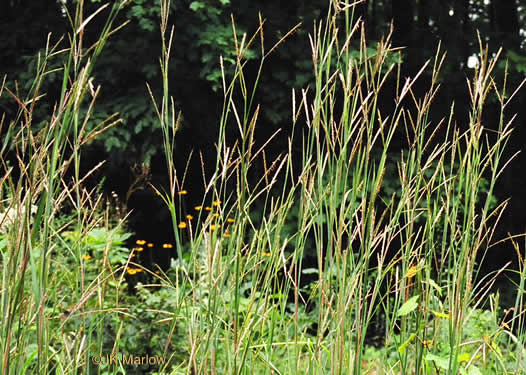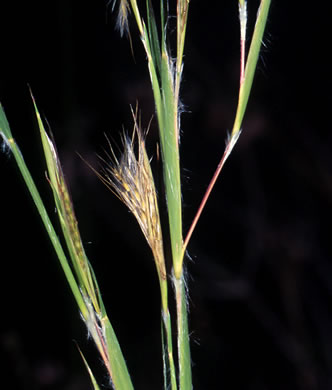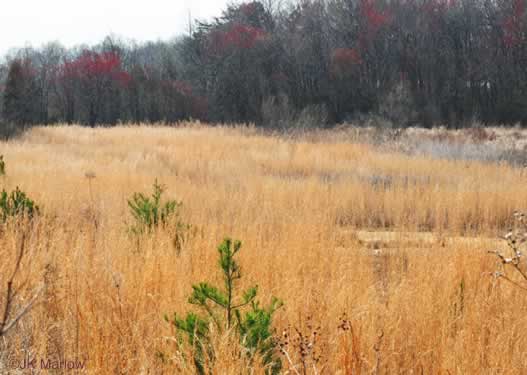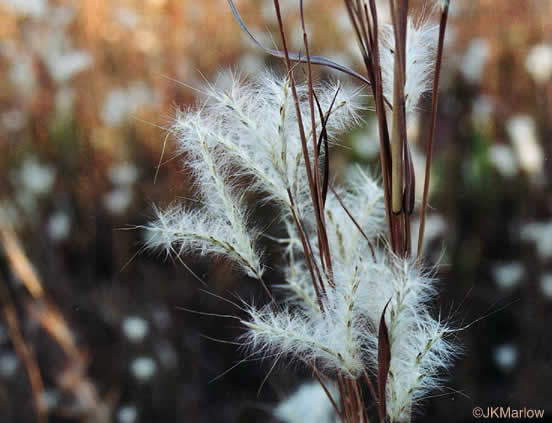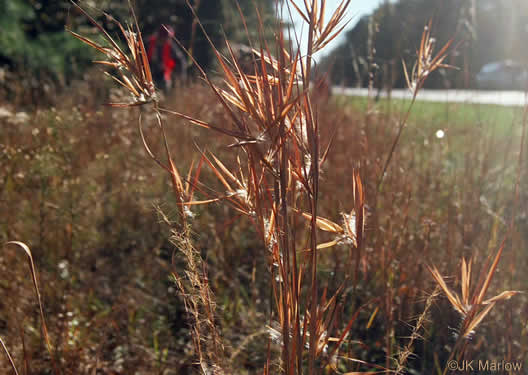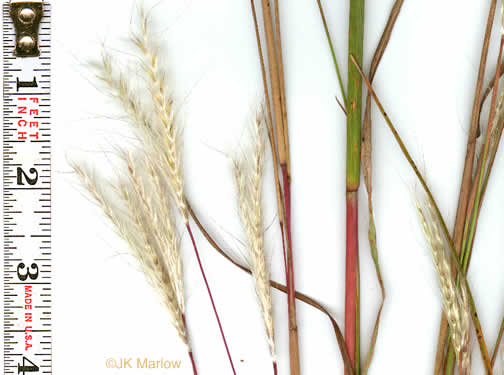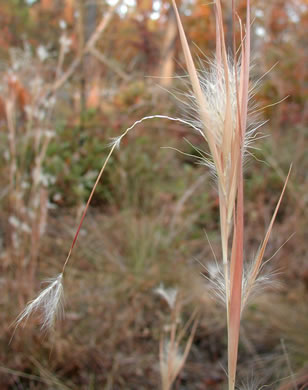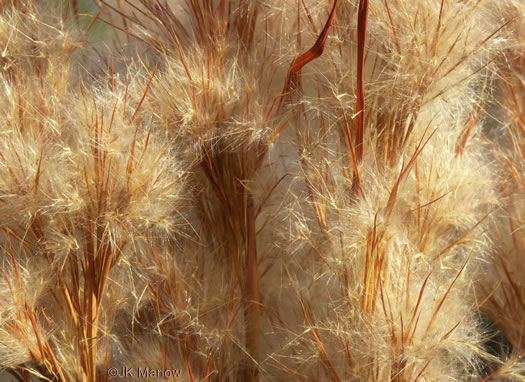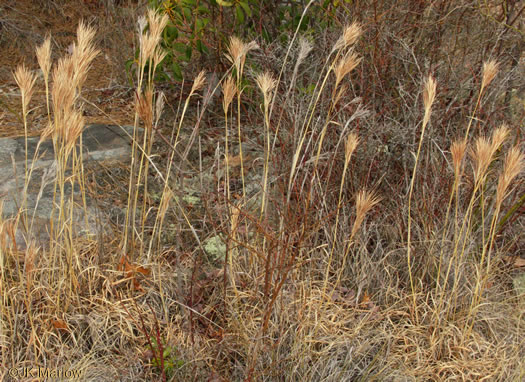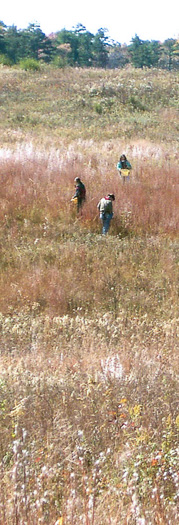The Other Bluestems
by Patrick D. McMillan*
Reprinted from the Winter 2002 Journal of the South Carolina Native Plant Society, and used by permission.
To see pictures or additional information about a particular plant, click its name.
Seventeen different taxa (types) of bluestem in the genus Andropogon can be found in South Carolina, but if you ask the average plant enthusiast to start naming them they might come up with only two or three. An amazing amount of information is available on bluestem.
The vast majority of this information will cover Big Bluestem (Andropogon gerardii) and Little Bluestem (Schizachyrium scoparium). There is little to no information about the other 16 types of Andropogon found in South Carolina. This is not only unfortunate for the bluestems, but also for us!
The “other” bluestems include species that are ecologically very important in the natural communities of South Carolina and also very attractive, in some cases bizarre, and nearly all are amenable to cultivation.
The genus Andropogon is represented in South Carolina by species that tend to occur in open, sunny conditions. It is hard to imagine a more important or widespread genus in grassland communities. Wiregrasses (Aristida stricta and Aristida beyrichiana) get a lot of attention for their importance in the longleaf pine community, yet these species only occur in approximately half of the areas where longleaf pine communities exist. The lowly bluestem is omnipresent!
Bluestem is found in flatwoods, savannas, Carolina bays, limesinks, prairies, glades, barrens, old fields, granite outcrops, maritime grasslands, sandhills, and roadsides. (GET THE IDEA?) Working as a plant ecologist, most of my field time is spent looking at Andropogon. The importance of bluestems in the natural landscape cannot be overestimated. They provide the basis of most of our grasslands and several species occupy an important niche by colonizing disturbed areas in the initial stages of succession.
Bluestems are often viewed as common and “weedy” species, mostly colonizing abandoned agricultural fields and roadsides. Nothing could be further from the truth! In fact, most species are typical members of undisturbed natural communities, all of them are native, and several are extremely rare and choosy about their habitat.
Consider Mohr's Bluestem (Andropogon mohrii). This species ranges only in the coastal plain from Virginia to Louisiana. This extremely “fuzzy” species (the teddybear of the Bluestem world) is found in permanently wet savannas and herb-dominated seepage slopes in eight states. It is currently considered extirpated in Virginia and is on the rare list in three of the other seven states (including both of the Carolinas). I consider this species to be an excellent indicator of very high quality savanna habitat. Inevitably, where I find this plant I also find many other very rare species!
Perhaps the best known of the “lesser” Bluestem species is the Broomsedge (Andropogon virginicus). The typical variety of this species is the most likely candidate for the weedy category. This variety is found only in areas that have been disturbed. Preferred habitats include roadsides, old fields, ditches, scrapes and ruts in longleaf pine flatwoods. This species has been so successful in colonizing these man-made habitats that its “natural” habitat has been obscured. I have never seen this plant growing in a truly “natural” area. It could be that the typical variety of Broomsedge was adapted to living among the native Americans and has greatly expanded its range with our destructive appetite.
Two other varieties exist, the Deceptive Broomsedge (A. virginicus var. decipiens) and the “smooth variant” (an undescribed variety). The Deceptive Broomsedge is one of the most important native grasses in the undisturbed longleaf pine flatwoods community and is confined to the coastal plain. The “smooth variant,” which truly lacks any pubescence in all its vegetative parts, is also found only in the coastal plain in Carolina bays and limesink depressions. The “smooth variant” is also unique for the species because of its blue-green foliage with folded leaves.
Other Bluestems colonize old fields, particularly the Split-beard Bluestem (Andropogon ternarius) and Elliott's Bluestem (Andropogon gyrans). Both of these species may also be found in quite natural conditions such as sandhills, f1atwoods, glades, outcrops and barrens. The Split-beard is fairly well known due to its snow-white and showy exerted spikes that in the fall transform many roadbanks into a virtual blizzard of white.
The less well-known Elliott's Bluestem is not as widespread or common but takes the most bizarre award. This peculiar plant may be found throughout the state in dry to sub-mesic grasslands. The complex inflorescence consists of swollen bracts and long-exerted spikes on twisted and contorted peduncles. While not as vibrant as the Split-beard, this species makes a very interesting and intriguing addition to the garden or the natural grassland.
Elliot's Bluestem is not a coarse species and stays rather short and tidy (less than 2 feet tall). In the fall, the foliage turns reddish and then golden in the winter. This species adds much interest to the landscape well into the dormant season. It is also a fantastic addition to a dried flower arrangement.
Several species of bluestem are limited to the coastal plain. One, the Longbeard Bluestem (Andropogon longiberbis) is considered to be extirpated in South Carolina, where it formerly occurred on Hilton Head Island.
Other unusual and “bulky” species include those in the Bushy Bluestem group. These species are termed bushy for their broom-like aggregations of racemes at the ends of each stem. Four types of Bushy Bluestems occur in South Carolina.
Maritime Bushy Bluestem (Andropogon tenuispatheus) is the most likely to be encountered. This very robust species may be found along roadsides and in disturbed habitats throughout the piedmont and coastal plain. The original habitat was in maritime grasslands and back-dune areas along the coastal fringe, where it still may be found. This species, which was already adapted to growing in continually disturbed situations caused by shifting sands and storms, found an easy access to the rest of the state along our well-developed highway systems. Several other species such as Groundsel Tree (Baccharis halimifolia) and Wax-myrtle (Myrica cerifera) have spread in a similar manner.
The other “Bushy” species include the Common Bushy Bluestem (Andropogon glomeratus var. glomeratus), which is not so common in South Carolina. This species may he found in savannas, pocosin ecotones and mountain bogs. The inflorescence is coarse and bushy but makes an interesting addition to a dried flower arrangement.
The Savanna Bushy Bluestem (Andropogon glomeratus var. hirsutior) is more typical of South Carolina where it occurs in savannas and pocosin ecotones throughout the coastal plain and sandhills. Both varieties are too coarse for most gardeners but are important ecologically and useful in restoration efforts.
A third “Bushy” species is the Coastal Bluestem, also known as Big Chalky Bluestem (Andropogon glaucopsis). This interesting species looks similar to a typical “Bushy” but has one obvious difference, the bright bluish-white foliage. This species may be found in wet flatwoods, savannas, and pocosin ecotones, as well as roadside ditches. It would be a great addition to the natural garden for those not too concerned with its huge proportions (often 5 feet or more tall).
Another, even more attractive species is a great candidate for every gardener, the Chalky Bluestem. Of course I saved the best for last!
The Chalky Bluestem (Andropogon capillipes) comes in two varieties, the dryland variety and the wetland variety. The dryland variety is the typical variety described by George Nash (1864- 1921). The wetland variety is undescribed. The wetland variety may be found in savannas, Carolina bays and limesinks throughout the coastal plain. This variety is not as showy as the typical variety, but is very distinctive due to the pubescence at the base of each raceme sheath and longer and less bluish leaves. The typical variety is the epitome of a bluestem and my favorite! This graceful species produces leaves and stems that are brilliant bluish-white and very tidy. It forms tight clumps of short leaves and in the fall produces a three-foot tall spike of short and dangling racemes. This is a perfect substitute for other bluish grasses such as ornamental Fescue, which are fairly tough to grow. The species is found in dryish sandy flatwoods and sand rims in the outer coastal plain. I can think of no better plant in the Lowcountry garden for year round color and intrigue. The species has recently become available from several commercial producers. Woodlanders in Aiken sells a fine selection.
Are you overwhelmed yet? Forgive my musings on this genus that is near and dear to my heart. I have spent the better part of the last decade documenting the ranges of these unusual species in the state and they hold a significant place in my studies. The genus Andropogon has it all, species which are rare and restricted in habitat, graceful and elegant species, and even species which have adapted so well to our own activities that they are more abundant today than at any time in their history. Hopefully you have a better understanding of the diversity found within this ecologically important genus, and maybe you will even consider them for use in your own landscape. The next time you see a Bluestem, you might think to yourself that this plant is a survivor, a specialist and the fabric that holds the fragile grassland ecosystems together.
* Dr. McMillan is a professional naturalist, lecturer, director of the South Carolina Botanical Garden and the Campbell Museum of Natural History at Clemson University, and the host, co-creator, and writer of the award-winning ETV nature series Expeditions with Patrick McMillan.

